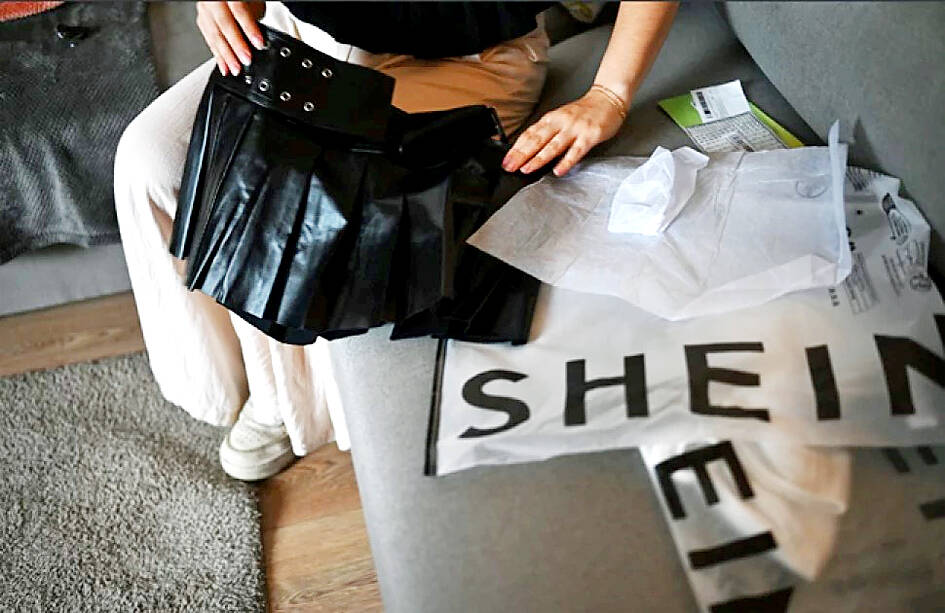From sizing advice via selfies to robot stock-takers, online shopping behemoths have increasingly turned to artificial intelligence (AI) in a bid to stem the flow of bad-for-business clothes returns.
Up to 30 percent of fashion items bought on the Internet are sent back, according to study late last year by consulting firm McKinsey and the Business of Fashion Web site — not least because “clients are buying several sizes or styles and returning most of them.”
That practice drags down profit margins. Each returned package costs between US$21 and US$46 on average given the costs of transport, treatment and making the item fit for selling again, a separate McKinsey study said.

Photo: AFP
SIZING ISSUE
“Seventy percent of returns are linked to a sizing issue,” said Zoe Tournant, whose company Fringuant markets an AI-driven algorithm to fix that, charging clients between 5,000 to 100,000 euros (US$5,240 to US$105,000) a year.
Armed with the customer’s height, weight and a quick selfie taken on the phone, the French-based start-up promises shoppers a better idea of what size would fit them best.
“With the selfie we detect their age, gender” to help “refine” the image of the customer’s body fed into its AI model, trained for a year on thousands of photos, Tournant said.
Within seconds, that model is then matched up with the garment’s dimensions provided by the brand to tell shoppers whether a jumper “falls perfectly on the shoulder” or if there are “doubts at the level of the hips” for a pair of trousers.
Tournant said her firm has about 20 clients, including upmarket womenswear label Maje, which she claimed has seen a dramatic drop in returns.
Similarly tempted by AI’s promise, Zalando acquired Swiss start-up Fision in 2020, one of a raft of companies working in the size-prediction niche.
Since July 2023, the German heavyweight retailer has adopted its own AI-driven sizing tool where customers help avoid returns “by taking two photos of themselves with their phone while wearing tight-fitting clothes,” Zalando said.
SHIPPING ERRORS
Besides sizing, e-commerce firms are also counting on AI to help avoid returns caused by shipping errors and automate their stock counts.
At ID Logistics, which operates in 18 countries, the order pickers’ trolleys are equipped with a smart camera to check that the color or size of the product retrieved from the shelves matches the order.
The device immediately alerts the worker if they have picked up the wrong item.
In less than two years, this camera has “reduced by 90 percent” the number of incorrect parcels, ID Logistics director of development and innovation Ludovic Lamaud said.
Elsewhere in the warehouse, an independent robot “rammed with AI” likewise maps the premises to “update the stock according to what it sees,” processing “6,000 to 30,000 pallets a night.”
“The right stock prevents preparation errors and therefore returns,” Lamaud said.

Asian perspectives of the US have shifted from a country once perceived as a force of “moral legitimacy” to something akin to “a landlord seeking rent,” Singaporean Minister for Defence Ng Eng Hen (黃永宏) said on the sidelines of an international security meeting. Ng said in a round-table discussion at the Munich Security Conference in Germany that assumptions undertaken in the years after the end of World War II have fundamentally changed. One example is that from the time of former US president John F. Kennedy’s inaugural address more than 60 years ago, the image of the US was of a country

‘UNUSUAL EVENT’: The Australian defense minister said that the Chinese navy task group was entitled to be where it was, but Australia would be watching it closely The Australian and New Zealand militaries were monitoring three Chinese warships moving unusually far south along Australia’s east coast on an unknown mission, officials said yesterday. The Australian government a week ago said that the warships had traveled through Southeast Asia and the Coral Sea, and were approaching northeast Australia. Australian Minister for Defence Richard Marles yesterday said that the Chinese ships — the Hengyang naval frigate, the Zunyi cruiser and the Weishanhu replenishment vessel — were “off the east coast of Australia.” Defense officials did not respond to a request for comment on a Financial Times report that the task group from

BLIND COST CUTTING: A DOGE push to lay off 2,000 energy department workers resulted in hundreds of staff at a nuclear security agency being fired — then ‘unfired’ US President Donald Trump’s administration has halted the firings of hundreds of federal employees who were tasked with working on the nation’s nuclear weapons programs, in an about-face that has left workers confused and experts cautioning that the Department of Government Efficiency’s (DOGE’s) blind cost cutting would put communities at risk. Three US officials who spoke to The Associated Press said up to 350 employees at the National Nuclear Security Administration (NNSA) were abruptly laid off late on Thursday, with some losing access to e-mail before they’d learned they were fired, only to try to enter their offices on Friday morning

CONFIDENT ON DEAL: ‘Ukraine wants a seat at the table, but wouldn’t the people of Ukraine have a say? It’s been a long time since an election, the US president said US President Donald Trump on Tuesday criticized Ukrainian President Volodymyr Zelenskiy and added that he was more confident of a deal to end the war after US-Russia talks. Trump increased pressure on Zelenskiy to hold elections and chided him for complaining about being frozen out of talks in Saudi Arabia. The US president also suggested that he could meet Russian President Vladimir Putin before the end of the month as Washington overhauls its stance toward Russia. “I’m very disappointed, I hear that they’re upset about not having a seat,” Trump told reporters at his Mar-a-Lago resort in Florida when asked about the Ukrainian